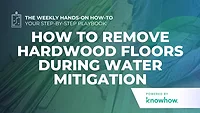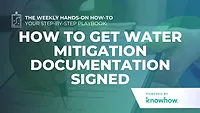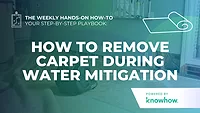Weekly Hands-on How-To powered by KnowHow
How To Dispose of Extracted Water Properly During Water Mitigation
Essential Steps for Efficient, Compliant and Safe Water Mitigation

When dealing with a water loss, extracting the water is only half the battle; how you dispose of it after extraction can delay claims progress, create legal headaches, and impact the company reputation if not handled correctly. One misstep in dealing with contaminated water could lead to complications like fines, property damage, or health hazards.
By following proper disposal protocols, you can ensure your operations stay efficient, compliant, and safe—saving time and preventing unnecessary setbacks. In this guide, powered by KnowHow, we’ll walk you through the essential steps for classifying wastewater, choosing the proper disposal methods, and documenting every step of the process. Whether it’s clean water, grey water, or black water, you’ll have the tools to handle it all with precision and professionalism.
Let’s dive in and make your next mitigation project one to remember—but for all the right reasons.
Note: This Weekly Hands-On How-To was based on this template in KnowHow’s template library.
Step 1: Identify the Type of Water Being Extracted
Before beginning the disposal process, it’s essential to understand the type of water you’re dealing with. Each category of water will have different disposal processes, and misclassification can lead to improper disposal, environmental harm, and non-compliance with local regulations.
There are three primary types of water you’ll encounter during mitigation:
- Category 1 (Clean Water): Originates from clean sources like broken supply lines and poses no significant health risks.
- Category 2 (Grey Water): Contains some contaminants and requires careful handling to avoid health hazards.
- Category 3 (Black Water): Heavily contaminated, potentially hazardous water often stemming from sewage or floodwater.
By accurately classifying the water, you’ll be equipped to choose the correct disposal method and avoid complications later in the process. To learn more about identifying water categories, click here.

Step 2: Check Local Regulations and Guidelines
Disposing of extracted water isn’t just about following best practices—it’s about adhering to the law. Each region has its own rules governing wastewater disposal, and violating them can lead to fines, environmental damage, or legal troubles.
Begin by researching local regulations specific to your area, focusing on wastewater classification and disposal standards. Speak to local agencies or consult guidelines from wastewater treatment facilities to understand acceptable methods. Pay close attention to restrictions regarding the use of sanitary sewer systems or requirements for hazardous waste handling.
Compliance is not optional—it’s the foundation of responsible water mitigation, and taking the time to understand the rules ensures your actions protect both the community and the environment.
Step 3: Use Appropriate Equipment for Water Extraction
The effectiveness of your entire mitigation effort depends on using the right tools and techniques to remove excess water safely and efficiently.
First, assess the type and volume of water present. For smaller volumes, a wet/dry vacuum may suffice, while larger areas will require heavy-duty tools like submersible pumps or truck-mounted extraction units. Position your equipment strategically to cover the affected space, paying special attention to corners and hard-to-reach areas.
When it comes to tools, choosing the right one makes all the difference:
- Wet/Dry Vacuums: Best for small-scale water removal on surfaces like carpets and flooring.
- Submersible Pumps: Ideal for deep water or areas with standing liquid.
- Truck-Mounted Extractors: Perfect for large-scale water extraction with maximum efficiency.
To learn more about using submersible pumps and truck-mounted extractors, read our previous how-to.

Step 4: Where to Dispose of Category 1 Water
Category 1 water is the easiest to handle, but that doesn’t mean it requires less care. Often clean enough for non-potable reuse, this type of water can typically be disposed of safely through sanitary sewer systems.
If allowed by local regulations, consider reusing Category 1 water for tasks like flushing toilets or watering plants. However, it’s crucial to verify the water is free of chemicals or contaminants before repurposing it. Whether reusing or disposing of this water, always document your actions to show compliance with local guidelines.
Step 5: Where to Dispose of Category 2 Water
Category 2 water requires a more hands-on approach due to its potential for contamination. Before disposal, this type of water must be transported to an approved wastewater treatment facility to ensure safe handling.
Begin by collecting the water in secure, labeled containers designed to prevent spills. Transport these containers carefully, following all local regulations for handling semi-contaminated water. Finally, document every step of the process, including the quantity of water transported, the facility used, and the date of disposal.
Step 6: Dispose of Category 3 Contaminated Water Safely
Category 3 water is the most hazardous and demands the strictest precautions. Often containing sewage, toxins, or harmful microorganisms, it must be handled by professionals trained in hazardous waste management.
Start by collecting the water in leak-proof, labeled containers. Transport the containers using vehicles equipped to handle hazardous materials and deliver them to a specialized treatment facility. Always follow the facility’s disposal protocols and document the process meticulously. Safely disposing of Category 3 water is vital for public health and environmental preservation.
Step 7: Monitor and Document the Disposal Process
Keeping accurate records isn’t just about compliance—it’s about accountability. Proper documentation ensures you can verify every step of the process, whether for insurance claims, regulatory audits, or client peace of mind.
Track the amount and type of water disposed of, as well as the methods and facilities used. Regularly inspect disposal areas for leaks or contamination, addressing issues immediately to prevent further damage. A well-documented process reflects your professionalism and commitment to doing the job right.
Keeping Wastewater Management in Check With KnowHow
From understanding water categories to complying with local regulations, every step ensures safety, environmental care, and a smooth mitigation process. By handling wastewater thoughtfully and documenting every detail, you not only avoid setbacks but also build trust with clients and demonstrate professionalism in your work.
KnowHow is here to make this critical process easier. As part of our Catastrophe Response Toolkit, this guide—and many others—ensures your team is prepared for every challenge, from extraction to final cleanup. With instant access to SOPs, training workflows, and industry best practices, you can tackle even the most complex mitigation projects with confidence.
Visit tryknowhow.com to explore the full Catastrophe Response Toolkit and take your restoration services to the next level.
Looking for a reprint of this article?
From high-res PDFs to custom plaques, order your copy today!








